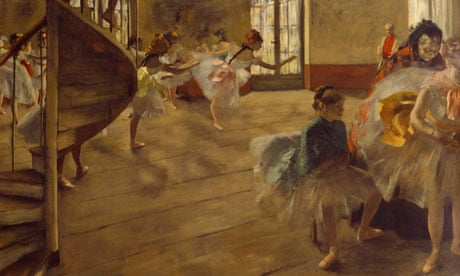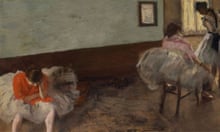Edgar Degas and ballet dancers is one of the great painterly partnerships, like Monet and lilies, Gauguin and Tahiti, or Lucian Freud and naked flesh. The world of the ballet, and in particular of the Paris Opera Ballet, was Degas's specialist subject, as well as the source of materials for his most popular and lucrative lines. Indeed it is impossible to think of him without thinking of floorboards and tutus, the endlessly reproduced Etoile of 1876/7, for instance, soaking up the applause with an elegant curtesy at the edge of the stage, or one of the many "Dance-classes" where young girls strike poses for their ballet master, Jules Perrot.
Indeed during the first few years of my life, one of those Perrot paintings, now in the Musée D'Orsay in Paris, was the sole representative of art in my little world, hung above the alcove in the sitting-room where I used to hide during Doctor Who. For a while I confused the Perrot with Harold Wilson smoking a pipe, an association I have never been able completely to forget.
Because Degas was so familiar, because I felt over-exposed to his talent and therefore somewhat inured to his charms, I acknowledged rather than appreciated the greatness of his work; he was the impressionist for people who didn't really like impressionists, the same prettiness but with line, structure and form, a brilliant draughtsman, yawn, a 19th-century classic. I even thought of missing the massive Degas retrospective that opened in New York in the winter of 1988, though it was not far from where I was living at the time; it would be uncomfortably crowded and Degas had not apparently been a very nice man, a grumbling grouch with a sarcastic wit in his early years, who evolved into an embarrassing antisemite.
I did go, however. It was crowded. And I was completely blown away. Degas didn't just paint dancers, I discovered, he painted horses and washerwomen and milliners, and women getting awkwardly in and out of bathtubs, or combing their or some other girl's hair. There were also some remarkable group portraits, of his relatives, the Belelli family, of the clerks in a New Orleans cotton exchange. Above all it was clear he was a risk-taker and an innovator. His compositions were daring and dynamic, combining radical foreshortenings and vast areas of "empty" space, Procrustean croppings and dangerous blockings of view, and an enormous variety of materials and techniques, greasy inks and essences – oil diluted with turps – powdery pinky pastels, plain old charcoal on bright green commercial paper or robin-egg blue, and all shapes and sizes, some huge some almost miniatures, some extremely elongated, some almost square. Some of the most extraordinary were fan-shaped.
Having been familiar with Degas for longer than I could remember, I now felt as if I had met him for the first time. Instead of merely acknowledging his genius, as a mark of my literacy and education, I recognised it, was overwhelmed by it.
The first effect of this conversion, however, was to split Degas in two: the ballet painter, endlessly reproduced, and the other Degas, the one I admired. It was only much later that I was able to see the ballet-pictures too as worthy of admiration, indeed as the laboratory for some of his most daring pictorial ideas.
Degas had started his career in the old fashioned way with life studies followed by trips to Italy and innumerable copyings of old masters. It was here that he refined his incomparable talent for drawing, but in his early years he was drawn to history painting – young Spartans, Semiramis – and the dreamy style of symbolists such as Pierre Puvis de Chavannes and Gustave Moreau. The turning point seems to have come with a startling painting of 1867 when he was in his mid-30s. A group of women in medieval-looking garb rest by a pool, the horse bows its head to drink, one of them plays a lute. It could almost be something from the studios of the pre-Raphaelites. But this is not some illustration of a legend, it is Mlle Fiocre in the ballet La Source, and therefore his first ballet picture, not that you would notice if the title didn't give the game away. By taking one step back from the drama, by framing his frame, so to speak, with a proscenium arch, he had in one instant shifted from being a painter of historical fantasies to a painter of modern life.
Within a few years he was a central figure in what has come to be known as the impressionist movement – "the pontiff of the sect" – taking a leading role in organising the first of the Salons Anonymes in 1874. In what would become a familiar pattern, the critics praised Degas and panned the rest. Degas nevertheless publicly stood by his new friends, although he also seems to have disliked Monet's work – he said it gave him vertigo – and could be sarcastic about their fondness for painting out of doors: "If I were the government, I would have a squad of gendarmes to keep an eye on these people painting landscapes from nature. Oh I do not wish anyone dead; I would however agree to spraying them with a little bird shot for starters."
By now his own preference was for the interiors of the Paris Opera, the off-stage spaces, the dingy classrooms and peeling walls. In fact four of his contributions to the 1874 exhibition were ballet pictures, and when Edmond de Goncourt visited him in February of that year he recorded in his diary that "After many attempts, experiments, and thrusts in every direction, he has fallen in love with modern subjects and has set his heart on laundry girls and danseuses."
Goncourt noted one particular painting that was not submitted to the salon but which features prominently in the Royal Academy's reassessment, Degas and the Ballet. Called simply The Rehearsal, it has some dancers relaxing with their chaperones in the foreground on the right, while more girls descend by means of a spiral staircase that blocks off the view on the left hand side. The rehearsal itself is going on in the middle distance above an acreage of floorboards. Just visible in the upper right is Jules Perrot with his big stick. It is a lovely example of a moment captured in real life, almost a fly-on-the-wall painting, with lots of things going on at once, people partially obscured, figures broken up by objects in the way, a pair of legs in the top left corner entering from the floor above, a snapshot of a moment in time in a place of bustling activity, people and objects not posed for a picture but chaotic and half-seen, as they are in real life.
But of course the picture has been very carefully composed. It is rigorously structured with strong diagonals, centrepoint and symmetries. The apparent chaos is resolved into a scene which is in practice clear and understandable, within a composition that achieves a satisfying equilibrium.
In fact The Rehearsal is in its own way a historical fantasy as imaginary as Semiramis contemplating the construction of Babylon. The room never existed in the Palais Garnier, but belongs to its predecessor the Opera Choiseul which had burned to the ground some years earlier. Jules Perrot is also unhistorical and misplaced, for the figure is taken from a postcard of him in his younger days when he was working for the imperial ballet in St Petersburg.
The organisers call the picture a manifesto and, looking at it, it becomes easier to see the, at first rather surprising, affinity the curmudgeonly bachelor discovered in this world of girliness and frills. First of all, amid the chaos Degas found endless repetition of standard movements and poses, providing plenty of opportunities for the relentless copyist, the champion draughtsman, to get some daring and implausible postures absolutely convincing and right, creating a series of interior landscapes accessible without having to go outdoors. Then, it provides a neat metaphor for the realist's quest for authenticity, the dingy truth of dingy classrooms that lies behind the Opera's glamorous stage façades.
But I think there is a much deeper affinity between the gentleman artist and his favourite subjects. There is something profoundly balletic about the way that Degas works the visual field, as a ballerina works an empty stage, the way he stretches perspective, pushes foreshortening, teeters on the brink of unbalancing, but balances, briefly, nevertheless. Now when I see that endlessly reproduced Etoile, I see the artist himself, acknowledging the appreciation, daringly poised.
Degas and the Ballet is at the Royal Academy from 17 September to 11 December.




Comments (…)
Sign in or create your Guardian account to join the discussion